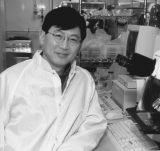|
||||||||||||||||||||||||||||||||||||||||||||||||||||

Stephen Y. Chou
|
Stephen Y. ChouJoseph C. Elgin Professor of Engineering, Professor of Electrical EngineeringPh.D. 1986, Massachusetts Institute of Technology
Advances in nanotechnology are presenting great opportunities for innovation and discovery in many engineering and scientific areas. This is because many conventional theories no longer apply in the nanostructures of a dimension smaller than some fundamental physical length scales. My group, the NanoStructure Laboratory (NSL), has two primary missions: first, to develop new nanotechnologies for fabricating structures substantially smaller, better, and cheaper than current technology permits; and second, by combining cutting-edge nanotechnology with frontier knowledge from different disciplines, to explore innovative nanoscale electronic, optoelectronic, and magnetic devices.
In the area of nanotechnology, we have developed a variety of nanofabrication technologies and fabricated various structures and transistors as small as 6 nm. A number of them are the smallest ever fabricated using the given technologies. For examples, we originated nanoimprint lithography (a revolutionary nanopatterning method with sub-10 nm features, low-cost, and high throughput) and lithographically induced self-assembly, LISA (a new self-assembly method). We fabricated nano-CDs with a density 400 Gbits/in2 (10 nm dots of 40 nm pitch). Recently we have demonstrated imprint of sub-100 nm features in organic light-emitting material on a flexible substrate for displays.
In the area of nanodevices, we have proposed and demonstrated a variety of new devices, such as the first room-temperature silicon single-electron transistor in which the current is switched "on" and "off" by a single electron; new quantum dot transistors that exhibit both Coulomb blockade and resonant tunneling; nanoscale photodetectors that have an 0.87 ps response time and a bandwidth of 510 GHz --the fastest reported at that time; subwavelength optical elements with the unique properties that are unavailable in bulk optics; and quantized magnetic disks --a new paradigm for the magnetic data storage having a density of orders of magnitude higher than conventional magnetic disks. NSL is equipped with a variety of the state-of-the-art nanofabrication and nanodevice characterization facilities from ultrahigh resolution electron beam lithography, nanoimprint lithography, interference lithography, thermal and e-beam evaporators and sputtering systems, and RIE etchers to scanning electron and scanning force microscopes, wavelength tunable femtosecond lasers, electric and magnetic measurement systems, and polymer characterization. The details of research and equipment are given at www.ee.princeton.edu/~chouweb |
|||||||||||||||||||||||||||||||||||||||||||||||||||
|
|
|
| Contents copyright © 2002 Princeton University Department of Electrical Engineering All rights reserved. |
|

